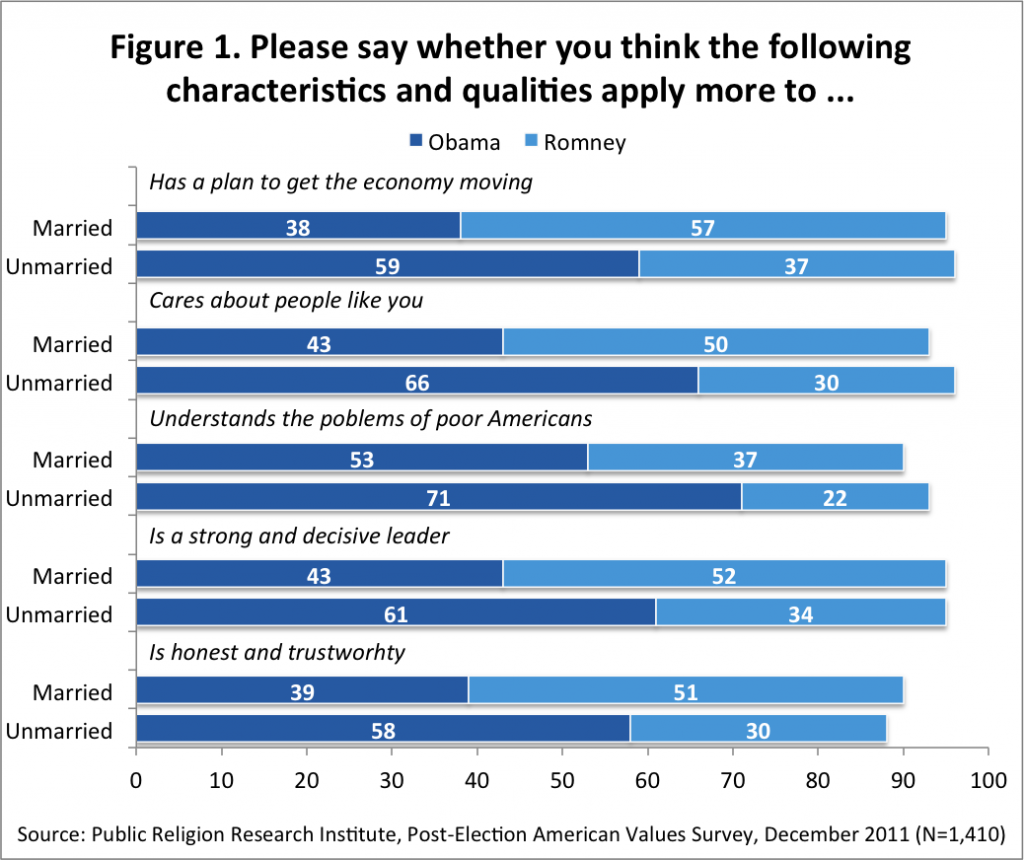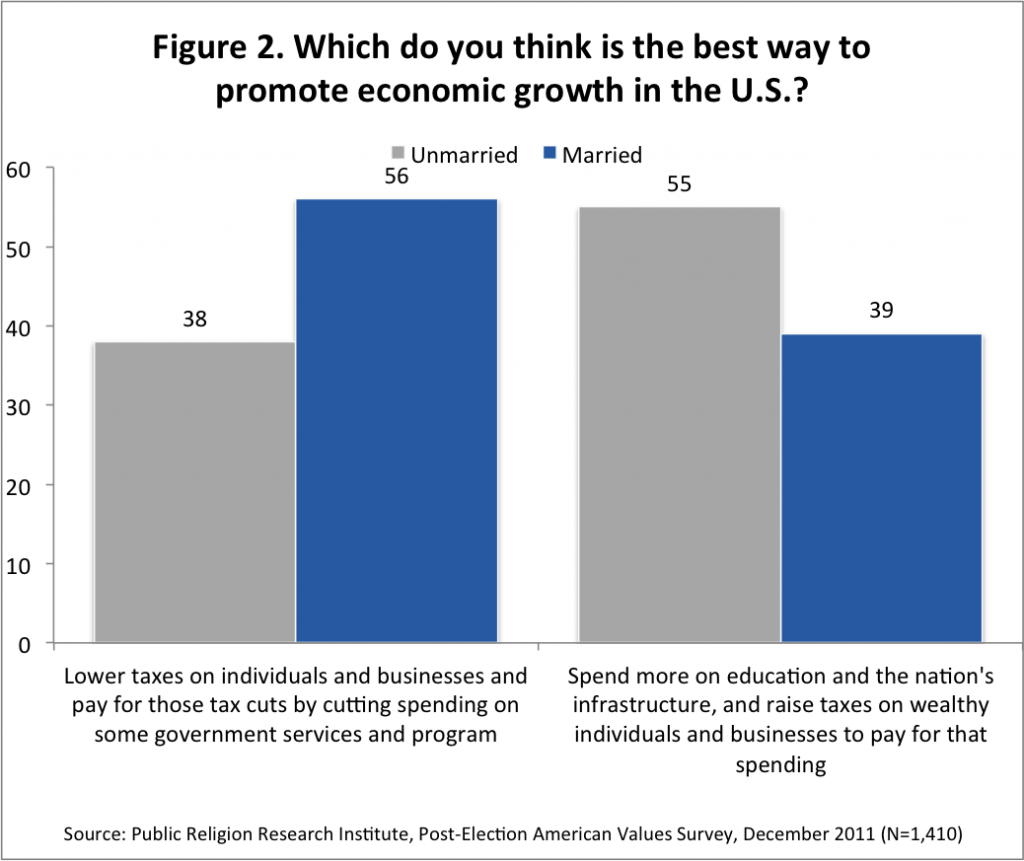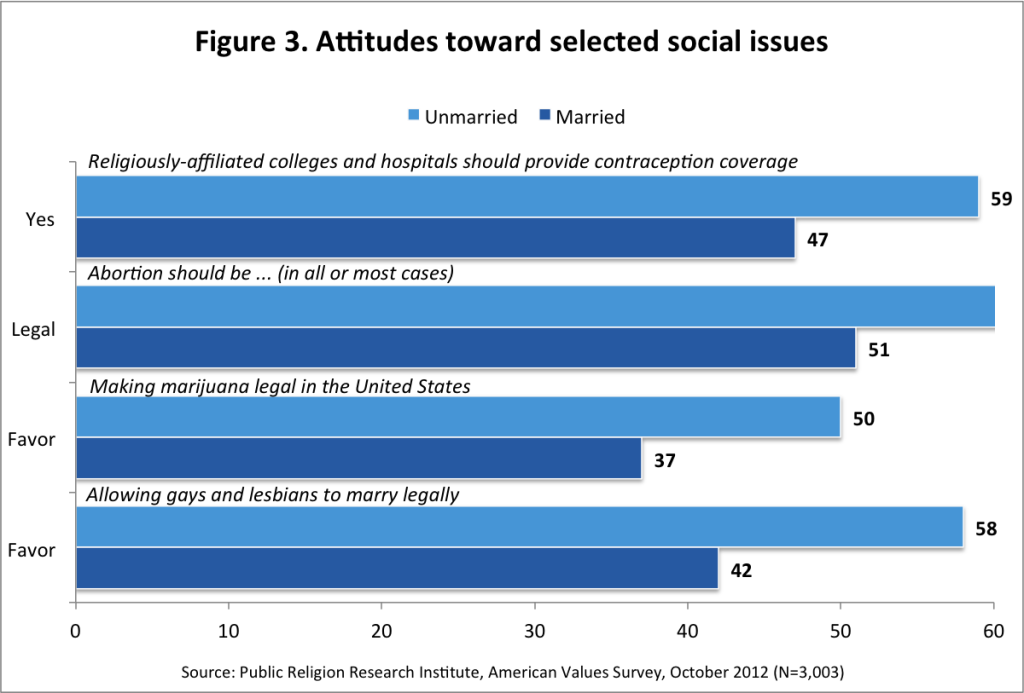In the aftermath of Mitt Romney’s loss to Barack Obama, analysts have noted that the Republican nominee lost in large measure due to changing American demographics—particularly the rise of the Latino vote, non-white Christians, and the religiously unaffiliated. But another demographic trend also threatens to hurt Republican chances in the future: the decline of marriage.
Exit polls show that married voters chose Mitt Romney over Barack Obama by a significant margin of 56 percent to 42 percent. But Romney lost voters unmarried voters by an even wider margin (35 percent vs. 62 percent). This marriage gap is nothing new: married folks have trended Republican in their voting behavior for the past two decades. Today, however, the Republican Party faces a stark reality: the percentage of adults who get married in the United States is on the decline. In 1960, 72 percent of adults were married; by 2010, that number had fallen to 51 percent. As a result, married folks have begun to make up a smaller slice of the electorate. While 66 percent of voters in 2008 were married, the percentage of married voters in 2012 hit a record low of just 60 percent.
Compared with unmarried voters, married voters are more likely to be white, to attend church frequently, and to describe themselves as politically conservative—characteristics that predict support for Republican candidates. However, studies find that marital status has an independent effect on presidential choice even while controlling for other demographic factors, so an examination of the political views of married and unmarried voters may help shed some light the 2012 presidential election results.
 PRRI’s American Values Survey and its more recent Post-Election follow-up survey illustrate three important reasons that Romney lost the unmarried vote. First, unmarried voters’ personal perceptions of the candidates differed dramatically from those of married voters, in ways that clearly benefited Obama. Figure 1 shows wide gaps in the leadership qualities that married and unmarried voters ascribed to the presidential candidates. Unmarried voters were significantly more likely to believe Obama better exemplified important leadership traits than Romney. They were more likely to see Obama as “honest and trustworthy”, and as a “strong and decisive leader”, than Romney. Given that the centerpiece of Romney’s campaign revolved around his business experience and plan to grow America’s economy, especially damaging to Romney was the perception among unmarried voters that Obama was far more likely (59 to 37 percent) to have a plan to get the economy moving than Romney.
PRRI’s American Values Survey and its more recent Post-Election follow-up survey illustrate three important reasons that Romney lost the unmarried vote. First, unmarried voters’ personal perceptions of the candidates differed dramatically from those of married voters, in ways that clearly benefited Obama. Figure 1 shows wide gaps in the leadership qualities that married and unmarried voters ascribed to the presidential candidates. Unmarried voters were significantly more likely to believe Obama better exemplified important leadership traits than Romney. They were more likely to see Obama as “honest and trustworthy”, and as a “strong and decisive leader”, than Romney. Given that the centerpiece of Romney’s campaign revolved around his business experience and plan to grow America’s economy, especially damaging to Romney was the perception among unmarried voters that Obama was far more likely (59 to 37 percent) to have a plan to get the economy moving than Romney.
 Second, the PRRI data show a deep divide among voters by marital status regarding the role of government in society. Nearly 6-in-10 (58 percent) married voters completely or mostly agree that government is providing too many social services that should be left to religious groups and private charities, compared with just 39 percent of unmarried voters. Moreover, married voters (48 percent) are far less likely than unmarried voters to agree that government should do more to reduce the gap between the rich and the poor (68 percent). And, as Figure 2 illustrates, married and unmarried voters hold distinct attitudes on the what government should do to promote economic growth in the US: while a majority of married voters supported the Republican view that lowering tax rates and cutting spending is the best way to promote economic growth, just 38 percent of unmarried voters say the same.
Second, the PRRI data show a deep divide among voters by marital status regarding the role of government in society. Nearly 6-in-10 (58 percent) married voters completely or mostly agree that government is providing too many social services that should be left to religious groups and private charities, compared with just 39 percent of unmarried voters. Moreover, married voters (48 percent) are far less likely than unmarried voters to agree that government should do more to reduce the gap between the rich and the poor (68 percent). And, as Figure 2 illustrates, married and unmarried voters hold distinct attitudes on the what government should do to promote economic growth in the US: while a majority of married voters supported the Republican view that lowering tax rates and cutting spending is the best way to promote economic growth, just 38 percent of unmarried voters say the same.
 Finally, the Republicans’ positions on culture war issues may have hurt them among unmarried voters. Data from the American Values Survey in Figure 3 show that unmarried voters hold far less conservative views on gay marriage, the legalization of marijuana, and abortion rights. They were also more likely than married voters to favor the Obama administration’s contraception mandate. And while unmarried and married voters alike clearly ranked economic concerns as their top issue in this election, the extremely conservative social views expressed by several Republican candidates, especially regarding rape and abortion, probably did not help the Romney ticket garner unmarried voters’ support.
Finally, the Republicans’ positions on culture war issues may have hurt them among unmarried voters. Data from the American Values Survey in Figure 3 show that unmarried voters hold far less conservative views on gay marriage, the legalization of marijuana, and abortion rights. They were also more likely than married voters to favor the Obama administration’s contraception mandate. And while unmarried and married voters alike clearly ranked economic concerns as their top issue in this election, the extremely conservative social views expressed by several Republican candidates, especially regarding rape and abortion, probably did not help the Romney ticket garner unmarried voters’ support.
These data illustrate that the GOP faces some significant challenges in reaching this growing segment of the American electorate. However, there are potential openings for the GOP to reach this group. For instance, unmarried men exhibit more conservative leanings, particularly in views about government. Nearly half (48%) of unmarried men agree that government is providing too many social services that should be left to religious groups and private charities, compared to 31% of unmarried women. Given their enhanced political clout, waiting for unmarried folks to get married is probably not the answer.




